By compensating for a missing copy of SCN2A, one of the genes most strongly linked to autism, a variant of the gene-editing technology CRISPR can reduce susceptibility to seizures, according to a new study in mice.
SCN2A…
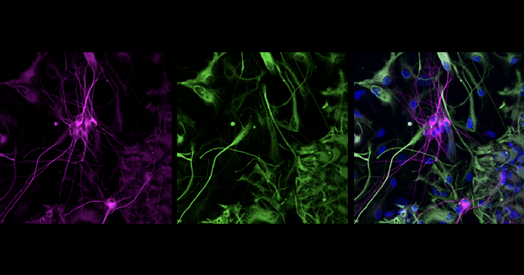
By compensating for a missing copy of SCN2A, one of the genes most strongly linked to autism, a variant of the gene-editing technology CRISPR can reduce susceptibility to seizures, according to a new study in mice.
SCN2A…

Unlock the Editor’s Digest for free
Roula Khalaf, Editor of the FT, selects her favourite stories in this weekly newsletter.
Europeans are at risk of cold showers after materials critical to hot water tanks were not included on an EU list of authorised substances, which was revised as part of the bloc’s sprawling environmental legislation.
Applia, the home appliance lobby group, has estimated that more than 90 per cent of hot water storage tanks would no longer be marketable in the EU if hafnium, a highly heat resistant metal, and its sister element zirconium are not recognised as safe for household use.
The two elements were not listed in the bloc’s rules for drinking water, which enter into force in 2027 and aim to protect consumers and improve water quality standards. The European Commission appears to have overlooked the fact that hot water tanks also hold potable water, with manufacturers warning they risk fines if they do not comply with the list of authorised substances.
“[Hafnium] is absolutely safe to use,” said Paolo Falcioni, director-general of Applia, stressing that the element had been used for more than 100 years in enamelled hot water tanks. If hafnium or zirconium are not mixed with the enamel, he explained, the glazing “cracks and the hot water is not hot”.
The two elements are also used in enamelling heat pumps, which have become more popular in recent years as households move away from gas boilers.
Falcioni said alternatives to hafnium, such as steel or copper, cost four to five times as much, which would be transferred to consumers at a time when household finances are tight.
“The impact would be huge,” said Jérôme Martel, regulatory affairs manager at the French heating and ventilation company Groupe Atlantic. Italy’s Ariston, another major manufacturer of hot water tanks, raised similar concerns.
European companies have pushed the commission to simplify the bloc’s regulatory burden, arguing it only adds to their woes ranging from high energy prices to US tariffs and cheap Chinese competition. Falcioni warned, however, that the complexity of the existing rule book also meant that more oversights, such as the exclusion of hafnium, were likely unless the commission paid greater attention to industry concerns.
The commission said it was up to member states to notify it of the need to authorise hafnium and so far none had done so. Brussels previously told companies they can apply for toxicological assessments to get them approved.
But industry argues this process would take too long and they would be forced to make costly changes to their production lines in the interim.
“This would place European manufacturers at a severe disadvantage compared to non-EU competitors,” said an industry executive, who asked not to be named.
Member states can approve hafnium’s use on a national level but this option is also costlier and more time-consuming than EU authorisation.
Falcioni warned the lack of regulatory clarity in this area risked deterring foreign investors, too.
“There are companies that are willing to reshore the manufacturing to Europe but without this certainty they may not,” he said.

Stay informed with free updates
Simply sign up to the Central banks myFT Digest — delivered directly to your inbox.
The writer is an external member of the Bank of England’s Monetary Policy Committee
Generations of economists — myself included — were taught to think about changes in economic activity primarily in terms of demand. But supply can prove every bit as consequential for output and inflation, as we recently experienced in the face of a pandemic and a war in Europe. We’ve learnt a number of lessons about how negative supply shocks propagate through the economy and how central banks might respond to them.
The conventional wisdom is that monetary policymakers should look through adverse supply shocks. First, they are often transitory and there is a lag before monetary policy has an impact on the economy, so any response would probably come to bear too late. Second, adverse supply shocks tend to push output down and inflation up. Monetary policymakers generally respond more cautiously to these shocks as they weigh the benefits of stabilising prices with the costs of weakening output. Third, if inflation expectations are well anchored, second-round effects should be avoided. Finally, interest rates are a demand-management tool, with little direct impact on supply.
In the face of recent supply shocks, inflation peaked at 9.1 per cent in the US, 11.1 per cent in the UK and 10.6 per cent in the Eurozone. More than five years after the onset of the pandemic, it remains above target in the US and UK.
The past few years have taught us a lot about the nature and transmission of supply shocks. First, different supply shocks can propagate through the economy in different ways. Recent research by Bank of England staff suggests a fall in productivity growth and a wage mark-up both result in a sharp initial jump in core inflation, but a negative labour supply shock results in a much more persistent rise.
The extent to which supply shocks have a lasting impact depends in part on whether second-round effects take hold, which act mainly through inflation expectations. The level of inflation influences how expectations form. Bank research shows households’ and companies’ attentiveness to inflation is greater when it reaches 3-4 per cent in the UK.
In projecting their own price growth over the next year, companies are more influenced by inflation changes when inflation is high than when it is lower, as it was before the pandemic. Household and company expectations are more sensitive to rising than falling inflation as well. Finally, expectations are particularly responsive to price changes in items such as food and energy.
The state of the economy matters when gauging whether elevated inflation expectations will feed into higher wages and prices. We saw this after the pandemic, when the inflationary impact of energy price and supply chain shocks was perpetuated by a tight labour market, boosting wage growth and services inflation. According to the bank’s Decision Makers Panel, many companies also set prices according to the state of the economy rather than on a schedule, and they changed their prices more frequently when inflation was high in 2022.
These lessons can help central banks respond to supply shocks both now and in the future. Last August, the Monetary Policy Committee considered a hypothetical scenario in which inflation expectations were more backward-looking and productivity growth was weaker than in our baseline forecast. This results in higher and more persistent inflation, barring a monetary policy response.
Bank staff then applied a policy rule that minimises deviations of inflation from target and output from potential, and prescribes a policy path to achieve this. The rule’s path is more restrictive than both the market curve underpinning our baseline forecast and the more recent, higher market curve — in fact it suggests a near-term rate rise.
This prescribed path is not gospel. Policy reversals undermine central bank credibility, and restrictiveness could also be achieved by skipping rate cuts.
Uncertainty around the structural features of an economy may affect the appropriate policy response as well. Bank research finds that if policymakers are uncertain about the persistence of inflation — as they are likely to be in the case of a supply shock — policy should respond more forcefully to inflation than under conditions of certainty.
Learning the lessons from recent supply shocks is not just an academic exercise. Transformational issues such as climate change, economic fragmentation and economic statecraft mean supply shocks are likely to become more frequent and successive.
Central banks need to understand how these shocks might impact the economy and how our policy stance might best evolve accordingly.
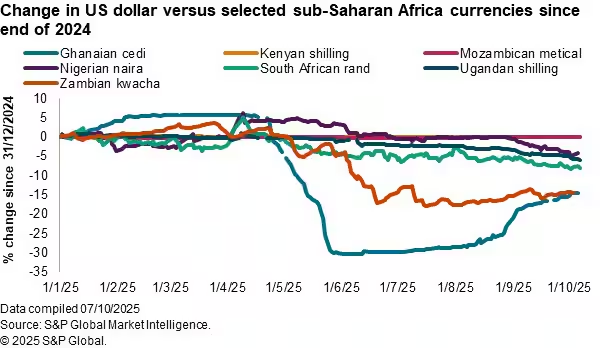
A number of economies in sub-Saharan Africa have seen
inflationary pressures wane in recent months amid currency
appreciation versus the US dollar. In turn, this is allowing
central banks to lower interest rates, helping business activity in
the region to expand solidly. PMI® data and the anecdotal evidence
provided by our survey respondents can help to illustrate the
impact of currency movements.
Of the seven economies in sub-Saharan Africa for which S&P
Global compile PMI surveys, five have seen currency appreciation
against the US dollar over the course of 2025 so far. While this to
some extent reflects the weakness of the dollar itself this year,
there have also been positive factors supporting local currencies,
including support from IMF programmes, fiscal consolidation and
tight monetary policy.
In particular, the Ghanaian cedi and Zambian kwacha have each
appreciated by 15% against the US dollar in 2025 so far, while the
South African rand and Nigerian naira have also seen gains.
Currency appreciation has contributed to a sustained easing of
inflationary pressures in the sub-Saharan Africa business sector.
PMI data showed that overall input costs increased at the slowest
pace since the COVID-19 pandemic in September. While selling prices
rose at a slightly faster pace than in August, here too the pace of
inflation was among the weakest in the past five years.
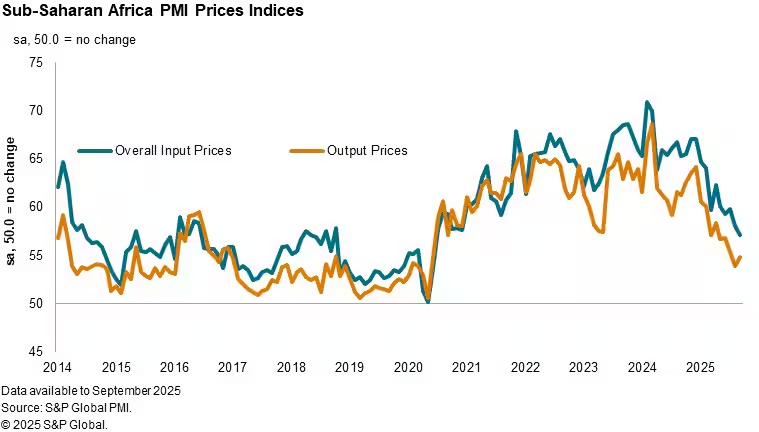
Country level PMI data show that most of the economies we cover
in sub-Saharan Africa have seen either a slowdown in inflation of
purchase costs or outright falls in prices over the course of 2025.
Those countries seeing the strongest currency appreciations against
the US dollar – Ghana and Zambia – have recorded periods of
decreasing purchase prices. Such price falls are rarely seen among
the sub-Saharan Africa PMIs, which normally suffer from marked
inflationary pressures. Even Nigeria, where purchase costs
continued to rise sharply during the third quarter, posted the
weakest pace of inflation since March 2020.
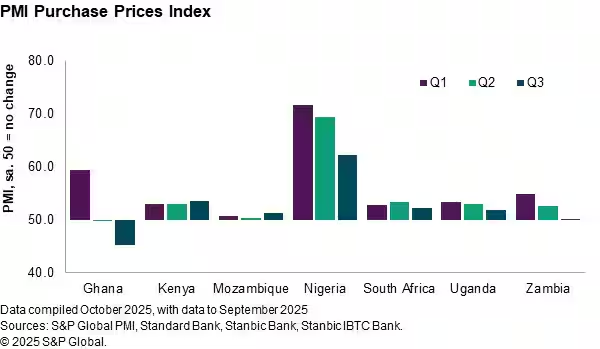
Anecdotal evidence from our PMI surveys can help us to see what
is driving the drop in price pressures in the region, with comments
from panellists highlighting the impact of currency appreciation on
purchase costs.
Normally we see any references to exchange rates or the dollar
being linked to rises in purchase prices as downward pressure on
local currencies feeds through to higher costs for imported items
and those priced in dollars. But between June and August this year
we recorded more mentions of these factors pushing down
prices rather than lifting them; the only time this has been the
case since we have had the full complement of seven sub-Saharan
Africa PMI surveys.
Similarly, recent months have seen above-average mentions of
either exchange rates or the dollar causing a drop in purchase
prices, to a degree second only to that seen in April 2024, when
firms in Kenya were responding to a substantial appreciation of the
shilling against the US dollar.
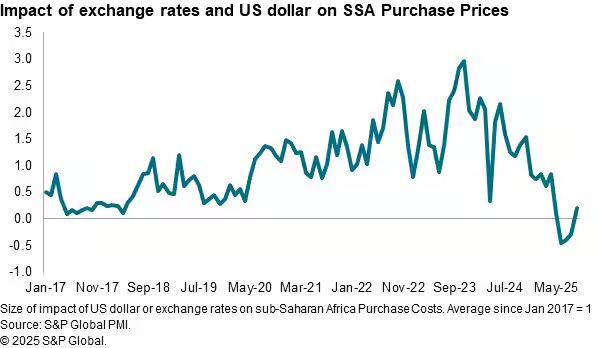
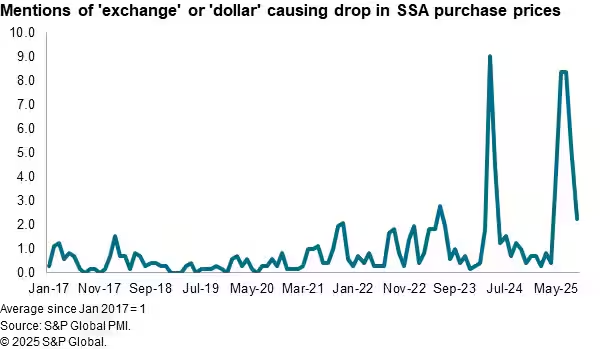
Easing inflationary pressures have enabled central banks across
much of the region to lower their interest rates over the course of
2025. Of the seven economies we cover, five have lower levels of
interest rates now than at the start of the year. Most notably is
Ghana, where the central bank has cut rates by 650 basis points in
the past two meetings. Interest rates in Uganda are at the same
level as they were at the start of 2025, while only Zambia has
posted an increase. Here though, S&P Global Market Intelligence
expects a cut of 50-100 basis points at the upcoming November
monetary policy committee meeting.

The softening inflation environment has coincided with a period
of solid growth in the sub-Saharan Africa private sector. September
saw output increase at the fastest pace in five months in response
to higher inflows of new orders. Employment rose for the twelfth
month running, while firms increased their purchasing activity and
inventory holdings.
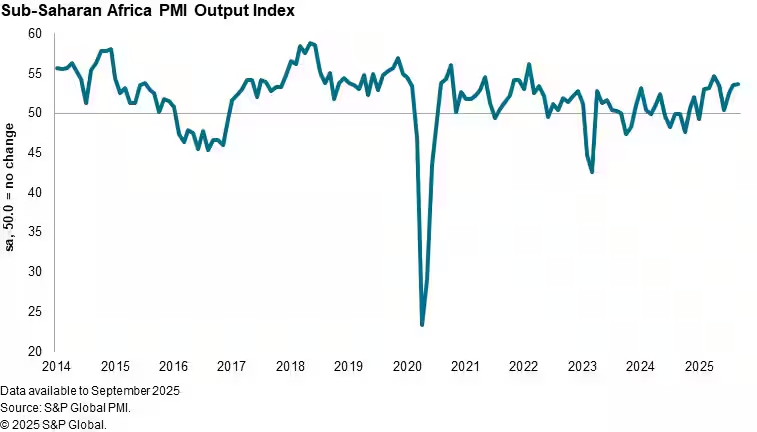
Most notably, the Stanbic Bank Zambia PMI signalled the fastest
rise in business activity since June 2023, while Stanbic Bank PMI
data for Kenya signalled a return to growth following mid-year
disruptions caused by protests. The only economy covered by PMI
data to see a drop in output during September was Ghana, but even
here new orders expanded and business confidence remained elevated,
meaning that we could potentially see renewed growth in the months
ahead.
Overall, the sub-Saharan Africa private sector enters the final
quarter of the year on a solid footing, in part at least due to the
currency gains seen over the course of 2025 so far.
Access the global PMI press releases.
Andrew Harker, Economics Director, S&P Global Market
Intelligence
Tel: +44 134 432 8196
andrew.harker@spglobal.com
© 2025, S&P Global. All rights reserved. Reproduction in
whole or in part without permission is prohibited.
Purchasing Managers’ Index™ (PMI®) data are compiled by S&P Global for more than 40 economies worldwide. The monthly data are derived from surveys of senior executives at private sector companies, and are available only via subscription. The PMI dataset features a headline number, which indicates the overall health of an economy, and sub-indices, which provide insights into other key economic drivers such as GDP, inflation, exports, capacity utilization, employment and inventories. The PMI data are used by financial and corporate professionals to better understand where economies and markets are headed, and to uncover opportunities.
Learn more about PMI data
Request a demo
This article was published by S&P Global Market Intelligence and not by S&P Global Ratings, which is a separately managed division of S&P Global.


Researchers from Osaka Metropolitan University have discovered how the balance of bacteria in the stomach affects the growth of neuroendocrine tumors (NETs). By identifying the specific bacteria involved and the biochemical…

Philippines – After debuting in India and Indonesia, OpenAI has expanded its cost-friendly subscription plan, ‘ChatGPT Go’, to 16 countries across Asia, aiming to make access to its GPT-5 model more affordable and widely…

The government has notified draft amendments to the Sharing of Assets of Civil Servants Rules, 2023, on Wednesday, as part of efforts to fulfill the IMF’s governance reform requirements, according to a news report.
The new rules mandate…

Menopause before the age of 45 (known as early menopause) is associated with an increased risk of an array of serious diseases, including cardiovascular disease and osteoporosis. A new study suggests that it may also force women out…